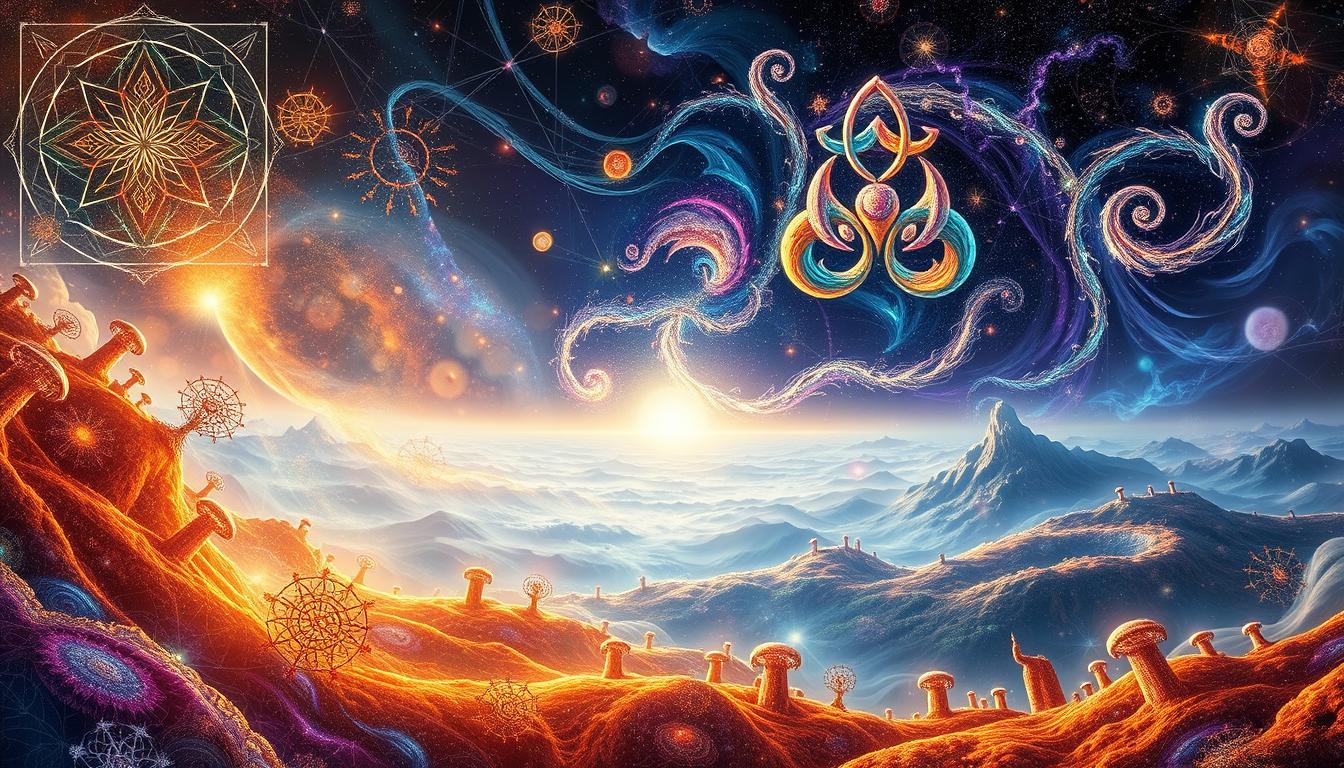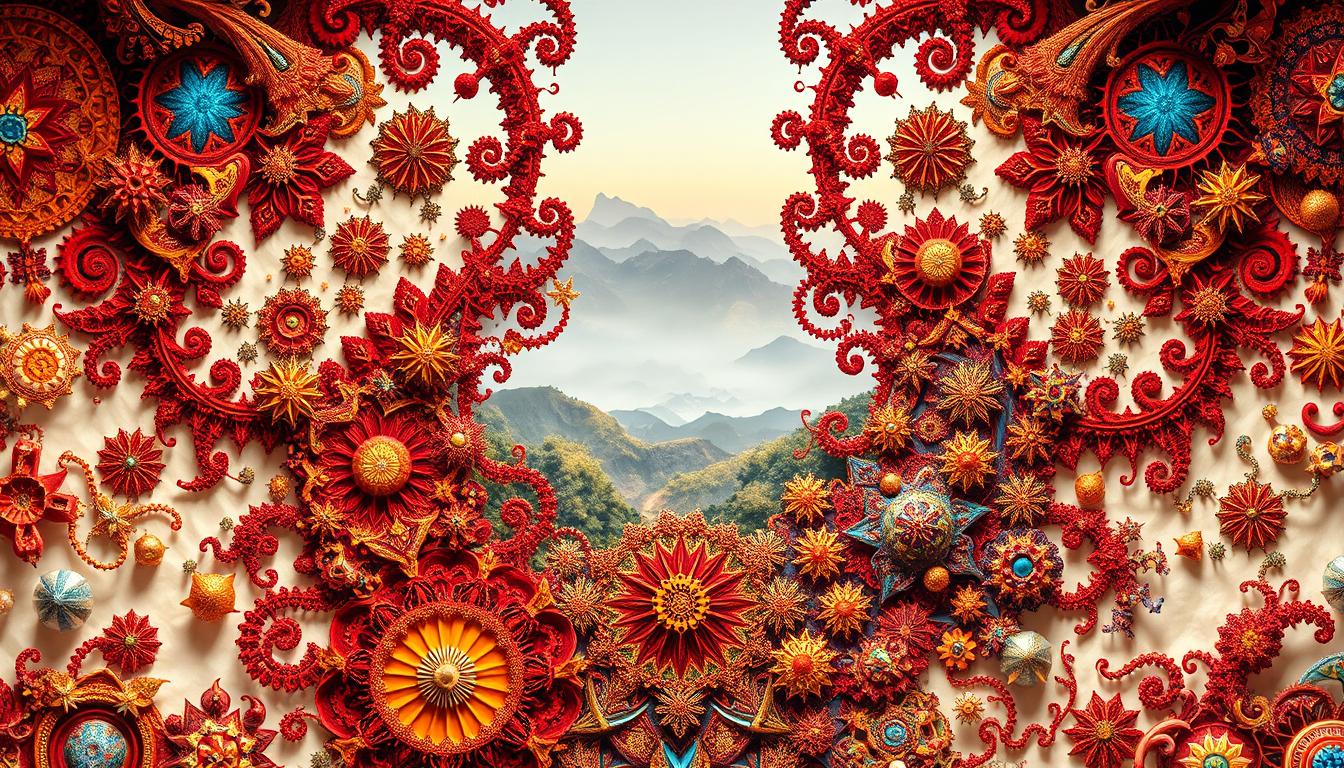Fractal harmony is deeply important in indigenous communities. It shows their unique cultural identity and love for interconnectedness. This idea is rooted in their culture, reflecting unity and teamwork.
The patterns of fractal harmony are key to their spiritual beliefs. They highlight the value of traditional customs. These customs have a lasting effect on the life of the community.
Understanding Fractals and Their Significance
Fractals are complex shapes made by repeating patterns. They look the same at different sizes. You can see fractals in nature, like in trees and coastlines. People are amazed by fractals not just because they’re beautiful.
In many old cultures, fractals show how everything in life is connected. These cultures use stories and art to share their deep knowledge. They show how people, communities, and the environment are all linked, just like fractals.
Studying fractals makes us see how nature and spirituality are connected in old stories. By looking at fractals, we think more about our role in the world. This helps us see how important it is to keep life in balance.

The Concept of Fractal Harmony in Indigenous Communities
Fractal harmony is key in indigenous communities, woven into their community values. It shows a pattern of connection found in various indigenous practices. Practices like storytelling and communal gatherings show life’s holistic nature.
How people interact shows the power of collaboration. It reveals patterns similar to those in nature. This way of connecting helps build strong bonds within the community.
These bonds pass from one generation to the next. They create a fractal structure. Small units in this structure reflect the larger systems they’re part of.
Understanding this interconnectedness helps us value their actions more. These actions affect the whole community. They help teach young people about their culture and bring everyone closer.
Historical Context of Indigenous Practices and Collaboration
Indigenous communities have a rich history that shows the strength of working together. Their practices, passed down through generations, highlight how important teamwork is. Stories from different areas show that sharing rituals, knowledge, and decisions helped strengthen their bonds.
Working together helped these communities face environmental and social challenges. This teamwork led to a healthy relationship with the environment and a strong community bond. Elders were key, as they taught the young to hold onto cultural values and practices.
Even when faced with colonization and modern changes, indigenous groups stayed united to keep their cultures alive. Their ability to adapt while holding onto their traditions shows the power of their collective spirit. This history isn’t just about their survival but also the vital role of unity in preserving their heritage.
Microanalysis of Fluid Collaboration in Indigenous Communities
Looking closely at indigenous communities shows us how they work together in amazing ways. Their teamwork is based on long-held traditions and a shared commitment to the group. Everyone pitches in, creating a warm and helpful environment that’s good for all.
Every day, these communities do things like farm together or tell stories as a team. Everyone gets to share their talents and learn from each other. This sharing builds a strong community where everyone respects and understands each other.
People in these communities are ready to switch roles as needed. This flexibility improves how they communicate and connect. It also makes their group efforts more successful. Their way of teaming up shows how inventive and strong indigenous people are, and how well they work as one.
Fractal Processes of Collaboration Among Cherokee Children
Cherokee children learn in rich and complex ways, deeply rooted in their culture. Elders are key, keeping knowledge alive and relevant. They ensure learning passes through generations, strengthening community bonds and continuity.
The Role of Elders in Passing Down Knowledge
Elders are the keepers of Cherokee traditions for the young. They share stories, songs, and ceremonies, teaching more than just facts.
This teaching includes values, ethics, and the community’s collective identity. Elders use storytelling and hands-on activities to make culture real and meaningful for children.
Fluid Collaboration in Intergenerational Learning
The partnership between Cherokee children and elders makes learning together natural. This not only helps kids grow but also strengthens community ties.
Kids learn to value their heritage and their place in it. By working together, children and elders gain a deeper understanding of their shared culture.
Fractal Harmony in Indigenous Communities
Fractal harmony is key in shaping how indigenous communities work. It shows how personal experiences mirror the wider community’s values. This creates a web of connectedness. By understanding fractal harmony, we see how communities support practices that come from indigenous values.
Within these groups, interactions mirror nature’s complex patterns. This shows connections are intricate, not simple. It gives a complete view of how people relate with each other and nature. Practices like storytelling and shared rituals show how these interactions are natural.
Through shared moments, everyone helps build a united identity. This focus on fractal harmony fosters teamwork. This teamwork comes from deep respect and connects various generations and cultures in indigenous communities.
In essence, fractal harmony helps us see the beauty in community dynamics. It shows how indigenous values influence ways of interacting, blending many cultural strands. By understanding this, we learn about the strength and continuity of indigenous lifestyles.
The Living Tree: A Metaphor for Interconnectedness
The living tree metaphor shows how connected we all are in indigenous cultures. It talks about community, growth, and how we all link to each other and nature. It fits well with what indigenous wisdom teaches, making us think about our role in nature’s health.
Understanding Akinoomaagewin and Its Relevance
Akinoomaagewin is a key idea in indigenous thought. It values learning from the natural world and what we do. This matches the living tree image where roots are our base knowledge and branches show how we grow in understanding. It stresses growing together as a community.
Being linked this way means what we do affects everything around us. Acknowledging Akinoomaagewin shows we know our part in community well-being. So, the living tree isn’t just a picture. It’s a way to live in sync with nature and indigenous wisdom.
Cultural Identity and Spirituality Reflected in Fractals
Fractals show deep aspects of cultural identity and spirituality in native communities. They are found in art, stories, and spiritual activities. These patterns form a vibrant picture that stands for the community’s shared beliefs and values. In art, fractal designs show how people connect with nature. This shows a belief in the interconnectedness of life.
Fractals are more than just beauty; they create a feeling of belonging. Through these designs, people share their view of the universe. This strengthens the ties within the community. Fractals let spirituality be expressed through repetition and complexity. This opens up ways to explore the mysteries of life and how everything is balanced.
These traditions clearly express cultural identity. The recurring themes show how life comes in cycles, emphasizing ancient wisdom and the need to live sustainably. When people use fractals, they not only hold onto their past. They also build a shared spirit that respects both history and what’s ahead.
Digital Archiving and Indigenous Knowledge
Digital archiving plays a key role in saving indigenous knowledge. It lets communities keep their cultural heritage and practices alive. This tech lets indigenous people own their stories and keep control over their cultural expressions. By using digital platforms, their knowledge is kept safe in ways that respect their traditions.
There are different ways to preserve culture with digital archiving:
- Creating digital repositories to store language, stories, and traditional practices.
- Utilizing multimedia to enrich the representation of cultural content.
- Engaging community members in the digitization process to ensure accuracy and respect for traditions.
Technology’s fast growth brings both risks and benefits for indigenous communities. The danger of misunderstanding and taking cultural materials is real. Yet, digital archiving lets indigenous voices get heard, spreading education and understanding. As tech grows, the promise to guard cultural knowledge in digital realms is essential for the future.
Conclusion
Our journey into fractal harmony in indigenous communities has revealed key insights. We’ve seen how their traditions and knowledge sharing unite them. Their social structures highlight the power of community in keeping cultures alive. These communities show the depth of their heritage and identity.
This concept underscores the value of respecting indigenous knowledge, even in our digital world. It shows the wisdom in their practices and their impact on today. By valuing their interconnected efforts, we foster conversations that respect their views.
Looking ahead, it’s crucial to include these insights in larger debates on social justice and sustainability. Fractal harmony reminds us of our past and guides our future cooperations. Embracing these insights enriches our understanding of indigenous cultures in our shared story.



